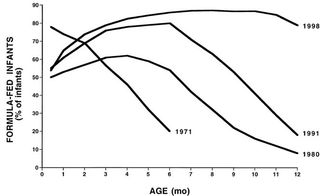Autism
Why Affluence Is the True Cause of the Real Autism Epidemic
A new study describes autism as caused by abundance of resources for growth.
Posted September 8, 2018
One of the first, and most counterintuitive insights offered by the imprinted brain theory was that, if paternally-active, growth-enhancing genes were in fact the cause of autism spectrum disorder (ASD), and growth-restricting, maternally-active genes the cause of psychotic spectrum disorder (PSD), environmental factors mimicking either might increase risk of ASD in affluent conditions while reducing risk of PSD, and vice versa. In fact, one of the very first posts on this site was devoted to making that point in relation to the so-called “autism epidemic.”
Indeed, as I pointed out there, birth weights of newborn babies in Vienna rose an unprecedented amount during the 1920s, perhaps partly explaining why Asperger was to discover the syndrome named after him during the next couple of decades. Furthermore, as I argued in The Imprinted Brain, where I first made this point, there is also good evidence for a decline in PSD in modern societies, complementing the so-called "autism epidemic" (pp. 168-171).
Now Amalia Megremi of the Ilion Socio-Medical Center in Athens has advanced what she calls in the title of her paper An "Abundance” Phenotype Hypothesis for Autism. She argues that there is much evidence "that an overgrowth pattern runs the autistic disorder as a whole, from prenatal period until adult life of the autistic individuals,” just as the imprinted brain theory claims. Specifically, she cites “Highly Proliferative Placentation,” which was the subject of a previous post and as I explain there is now the basis of a proprietary diagnostic test for ASD.
Megremi also lists enhanced levels of brain-derived neurotrophic factor (BDNF), also discussed in an earlier post along with “Increased Levels of Growth Hormones, Megalosomy and Obesity in Autism.” The paper also cites what has been by far the most remarkable confirmation of the link between birth size and risk of mental illness to date: a huge Danish study which confirmed that bigger babies have increased risk of ASD but reduced risk of PSD and smaller ones vice versa. Indeed, Megremi even notes the link between autism and cancer, which the imprinted brain theory predicts and which was so furiously contested when I mentioned it in a previous post that I had to publish another in reply.
As this paper also notes: “Many studies have ... shown that maternal metabolic conditions during pregnancy such as diabetes (both pre-gestational and gestational) and obesity may be broadly associated with neurodevelopmental problems in children, included ASDs.” What it does not add is that the gene responsible for gestational diabetes is paternally active, as predicted by the imprinted brain theory, and that the gene responsible for gestational hypertension (which increases blood supply and thereby nutrition to the placenta) is the same. This leads to a discussion of BMI and autism, to which I have also devoted a post.

When mentioning all this in talks, people would often ask me what specific factors in the mother’s diet might contribute to raising risk of ASD. As the figure left illustrates, my suggestion was infant formula, and Megremi agrees that feeding with formula milk leads to a greater rate of growth […]. The formula-fed infants are generally bigger and heavier than breast-fed infants. When cow’s milk formula is fed to human babies, they grow faster and bigger, because cows grow faster than human.
What she does not say is that breast milk content is controlled by maternal genes. It is comparatively thin and watery (suggesting maternal economy on nutrients) and contains opiates, which make the baby sleepy, along with fatty acids critical for growth of the parts of the brain where maternal genes are predominantly expressed (the cortex, as I describe in an earlier post).
As to food-supplements:
When there is excess folic acid, cell division (especially in neural tissue) may be more vigorous. This could be a possible explanation for rapidly increased brain cell numbers (megalocephaly) and cortical thickness in autism. Moreover, there is recent evidence that folic acid leads to increased methylation of the maternally imprinted insulin-like growth factor 2 (IGF2) gene, possibly due to a relative intrauterine silencing of IGF2.
IGF2 is the key paternally active growth gene, and the subject of several posts here.
As for "Autism and Socioeconomic Status: It seems that autism prevalence is higher in wealthy populations […]. It is assumed that the higher educational level in these populations results in better accessibility of diagnostic and treatment services. However,” this author adds that “no one can rule out other etiological factors of the phenomenon,” and leaves it at that.
Finally, the author asks if, as the diametric model of mental illness argues,
autism and schizophrenia are diametrically opposite diseases and if schizophrenia is associated etiologically with an environment of deprivation, thriftiness and undergrowth, it is reasonable for a question to arise: is the overgrowth pattern that runs through … the autistic disorder associated with an environment of abundance and oversupply?
According to the imprinted brain theory, the answer is Yes; but only because environmental abundance and oversupply mimic and reproduce the underlying genetic cause: paternally active, growth-enhancing genes such as IGF2.
Indeed, if you think about it, this is a general principle: Environment can only influence organisms in ways to which their genes have already predisposed them to be influenced, and autism is perhaps one of the best examples you could find. Even at the cognitive level, where autistic savants show prodigious learning abilities, what they can learn is highly constrained and symptomatically mechanistic: once again, thanks to paternally active genes and their effects on brain development and/or deficits in the mentalistic contribution of maternally active genes. To make the same point another way, you could say that this paper attempts to explain how the modern environment contributes to ASD, but that only the imprinted brain theory can provide the why.
References
Megremi; JAMMR, 26(7): 1-14, 2018; Article no.JAMMR.41138
Retamal, R., Mascie-Taylor, C.G.N., Villegas, R. et al. Relationship between age at giving fortified powdered cow’s milk and cessation of breastfeeding on the nutritional status of a Chilean child cohort followed from birth to 3 years of age. Eur J Clin Nutr (2020). https://doi.org/10.1038/s41430-020-0665-9




